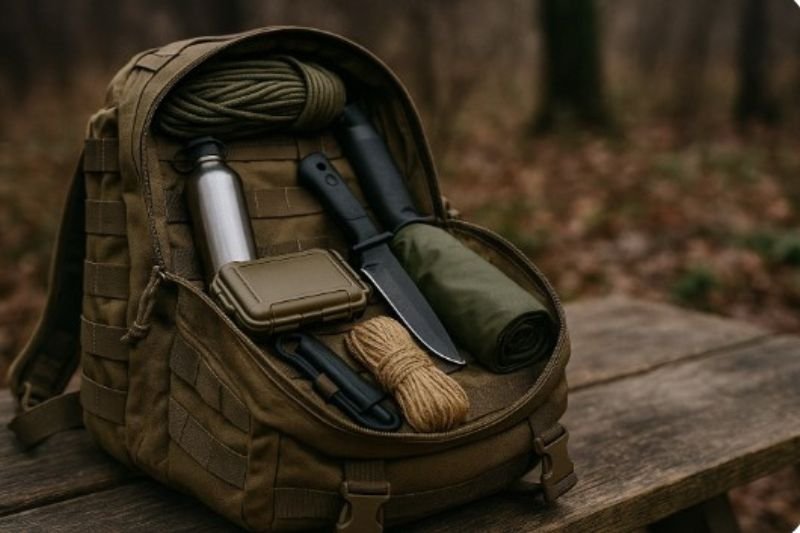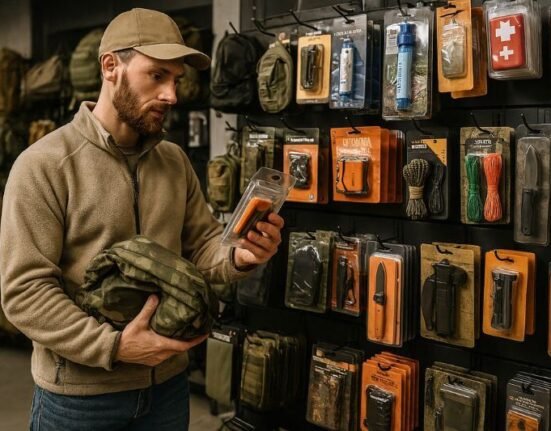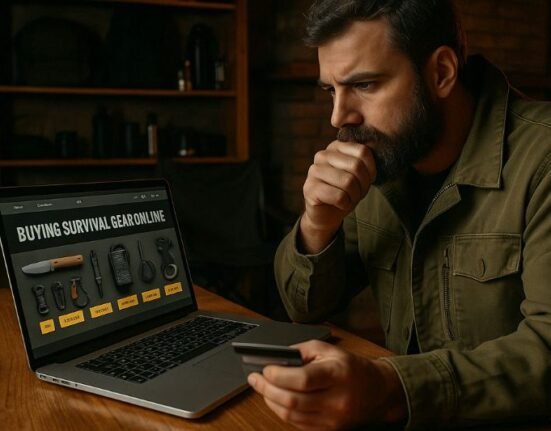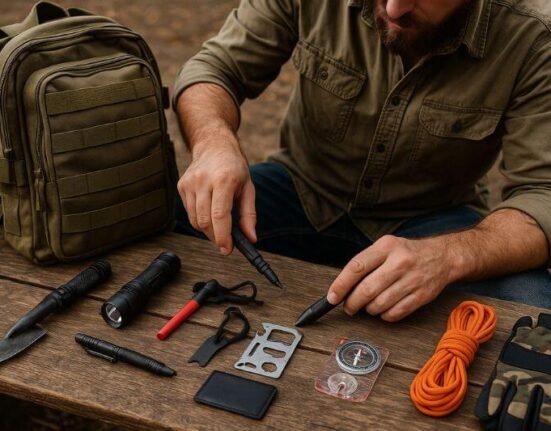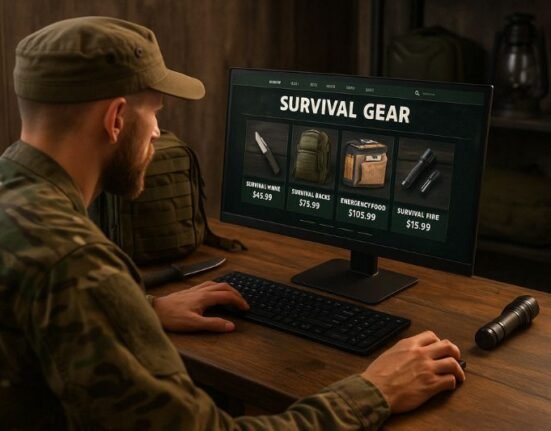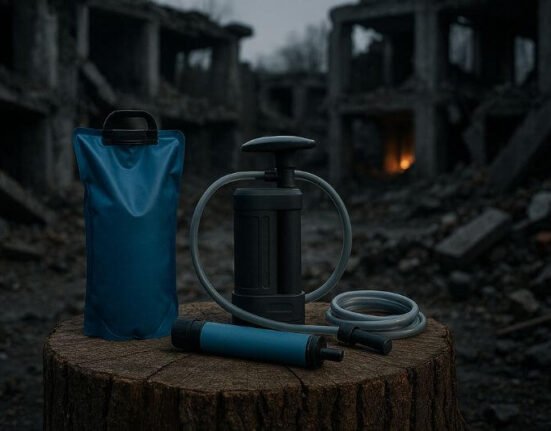When disaster strikes, your survival backpack isn’t just a piece of gear—it’s your lifeline. Whether you’re evacuating during a wildfire, navigating through post-collapse urban chaos, or hiking into the backcountry to escape danger, your backpack becomes your mobile survival base. And if it fails, so do you.
Understanding survival backpack features is essential for building a system that won’t let you down when it matters most.
Your Backpack Is Your Lifeline
Let’s be clear: a survival backpack isn’t the same as a schoolbag or a hiking daypack. It must carry your core survival items, and endure conditions that most civilian gear was never built for. It should be:
- Durable enough to survive abrasion, rain, mud, heat, and cold
- Ergonomic enough to carry for hours without injury
- Modular enough to adapt to shifting missions (urban bug-out, rural recon, shelter carry)
In a true crisis, you don’t get a second chance. If your straps break, your zipper fails, or your pack soaks through… you’re compromised.
What a Survival Backpack Must Carry
To understand the function of your backpack, let’s look at what it’s expected to hold. Depending on your plan (72 hours? 5 days? indefinite?), it may need to carry:
- 🔥 Fire-starting tools (ferro rod, lighter, tinder)
- 💧 Water filter, purification tablets, collapsible bottles
- 🍫 Rations and high-calorie food bars
- 🛠️ Multitool, flashlight, batteries
- 🧣 Emergency clothing (socks, base layer, gloves)
- 🛏️ Shelter gear (tarp, bivy sack, emergency blanket)
- 💊 Medical kit (IFAK or extended trauma kit)
- 📡 Maps, radio, compass
- 📄 Documents, cash, identification (in a waterproof sleeve)
That’s a lot. Your backpack needs to hold it securely, without becoming unwieldy or exposing items to damage.
Survival Backpack vs. Regular Hiking Backpack
| Feature | Survival Backpack | Hiking Backpack |
|---|---|---|
| Material | Heavy-duty nylon / Cordura | Lightweight synthetics |
| Pockets & Access | Multiple external + internal | 1–2 main compartments |
| Water Resistance | Often built-in or compatible | Often needs separate rain cover |
| Attachment System | MOLLE / webbing / compression | Limited or none |
| Color & Profile | Earth tones, gray, black | Bright colors, high visibility |
| Stealth & Tactics | Designed for discretion | Often visible and bulky |
Survival requires more than comfort—it demands durability, modularity, and stealth. While hiking backpacks may save ounces, they don’t survive flames, barbed wire, or combat zones.
Weight Distribution and Ergonomics
Carrying 10 to 20 kg for long distances is physically demanding. Good survival backpack features always prioritize weight distribution:
- Padded shoulder straps reduce pressure points
- Chest strap stabilizes the load across your upper body
- Padded waist belt redistributes weight to your hips
- Internal frame (or rigid back support) enhances stability
✅ Pro Tip: The center of mass should sit close to your spine, between your shoulder blades and lower back—not hang below your hips.
Don’t Let Your Backpack Betray You
The most common backpack failures in survival settings include:
- Broken zippers or seams due to overloading
- Shoulder straps tearing from stress
- Soaked interior from low-grade materials
- Poor stitching unraveling under motion
- Lack of ventilation causing sweat-soaking and chafing
This is why experienced preppers always field-test their backpack before an emergency. Try it on a weekend hike—fully loaded. Adjust. Repurpose. Train.
The Backpack Is Part of Your Survival Mindset
Owning the best tactical backpack on the market means nothing if you haven’t tested it under pressure.
- Can you access your fire kit in the dark?
- Can you repack it under stress in 5 minutes?
- Does it make noise while you move?
- Can you carry it 10 km without injury?
These aren’t hypotheticals. In survival, every piece of gear must become an extension of your body—and your pack is no exception.
Case Study: Ukraine 2022, Civilian Evacuations
During the early stages of the invasion, thousands of civilians in eastern Ukraine were forced to evacuate on foot—many without vehicles or aid. Journalists and survivalists noted that those with modular tactical backpacks fared better: they moved faster, had better weather protection, and kept vital supplies safe.
One survivor noted that her MOLLE-compatible survival backpack let her attach extra pouches for baby supplies without repacking everything—a detail that likely saved her child’s life.
Final Thought
Before you look at specs and brands, understand this: a survival backpack is your home on your back. It must be strong, stealthy, and purpose-built for crisis. Forget fashion, forget lightweight marketing. What you carry—and how you carry it—will define your chances in the field.
Core Survival Backpack Features You Should Never Compromise On
You’ve understood why your pack matters. Now let’s get into the specifics.
Not all backpacks are built for survival, and choosing the wrong features can cost you time, energy—or worse, your life.
Here’s a breakdown of the non-negotiable survival backpack features every prepper, homesteader, or urban evacuee should look for.
🎒 1. Material Strength and Durability
Your backpack must resist tearing, abrasion, water, and impact. The best materials are:
| Material | Strength | Water Resistance | Weight | Notes |
|---|---|---|---|---|
| 1000D Cordura | ★★★★★ | ★★★★☆ | Medium | Military-grade, abrasion-proof |
| 600D Polyester | ★★★☆☆ | ★★★☆☆ | Light | Cheaper but less durable |
| Ripstop Nylon | ★★★★☆ | ★★★★☆ | Very Light | Good for modular pouches |
✅ Pro tip: Choose a backpack with double or triple stitching, reinforced seams, and bar-tacked stress points.
💧 2. Built-in Water Resistance
Rain is inevitable. Your survival backpack should resist water by design—not just rely on a flimsy cover.
Look for:
- PU-coated or PVC-lined interiors
- Water-resistant zippers (with storm flaps)
- Seam-sealed compartments
- Drainage grommets (especially for wet gear compartments)
✅ Bonus: Integrated dry-bag compartments are ideal for protecting electronics and documents.
🔩 3. Zippers, Buckles, and Closures
These are your failure points. Weak closures = dead weight.
- Choose YKK or SBS zippers—the most durable
- Look for silent zippers (non-metallic pulls) for stealth
- Side-release buckles should be thick, not flimsy
- Add quick-access pull tabs for gloved operation
✅ Field-test: Can you open every pouch with one hand in the dark and cold?
📦 4. Capacity and Compartment Design
Forget liters—think systems.
- Minimum for Bug-Out Bag: 35–50L
- Long-term or winter survival: 50–70L+
- Modular designs: multiple internal and external compartments
- Dividers for medical gear, hygiene, dry food, tools
Your backpack should allow:
- Easy weight distribution
- Access without unpacking everything
- Compartmentalized redundancy (2 fire kits, 2 water options, etc.)
🧰 5. MOLLE Compatibility and Expansion
MOLLE (Modular Lightweight Load-carrying Equipment) is a military-born system that allows you to attach:
- First aid kits
- Ammo or tools
- Flashlight holders
- Cooking pouches
- Water bottle carriers
✅ Look for PALS webbing on the front, sides, and bottom. A survival backpack without MOLLE is a closed system—you want one that adapts as your needs change.
🛑 6. Accessibility in High-Stress Moments
Imagine needing your trauma kit while someone’s bleeding—or your radio during a power outage.
Essentials should be:
- Stored in predictable, muscle-memory locations
- Accessible without removing the pack
- Clearly organized by color or feel (ex: red tab for medical)
✅ Add rip-away pouches for medkits or EDC tools.
🔋 7. Hydration System Compatibility
Dehydration kills faster than hunger. Your pack should either:
- Include a hydration bladder (2–3L)
- Be compatible with one (tube exit ports, anchor loops)
- Have dedicated side pouches for water bottles
- Include drainage grommets in water compartments
✅ Tip: Use collapsible bottles in addition to a bladder to reduce bulk.
🏕️ 8. External Attachment Points
Not everything fits inside. Use external loops and straps to secure:
- Sleeping pad or bivy bag
- Folding saw or axe
- Tripod or trekking poles
- Wet gear (drying while hiking)
Look for:
- Adjustable compression straps
- Shock cord systems
- Bottom-mounted gear loops
✅ Make sure nothing dangles or rattles—it should move with your body, not against it.
🧤 9. Comfort and Load Bearing Design
Survival may mean walking 20+ km in rough terrain. Your backpack must move with you, not fight you.
Key ergonomic features:
- Contoured, padded shoulder straps
- Adjustable sternum strap
- Wide padded hip belt with lumbar support
- Breathable back panel (with airflow channels)
- Internal or removable rigid frame
✅ Warning: If you feel fatigue or back pain after 30 minutes with your pack—it’s the wrong pack or the wrong fit.
🎯 10. Color, Stealth, and Camouflage
Bright orange might look “cool,” but it’ll make you a target.
Choose:
- Earth tones (coyote, olive drab, ranger green, grey)
- Non-reflective zippers and trims
- Minimal logos or branding
- Quiet materials (no plastic swish sounds)
✅ In urban collapse, the “gray man” look (neutral, nondescript) is safer than obvious military styling.
🔍 Feature Checklist Summary
| Feature | Must-Have? |
|---|---|
| 1000D+ material | ✅ |
| Waterproof or resistant | ✅ |
| YKK zippers & strong buckles | ✅ |
| 35–70L capacity | ✅ |
| MOLLE system | ✅ |
| Hydration support | ✅ |
| Ergonomic fit | ✅ |
| Stealth color | ✅ |
| Modular compartments | ✅ |
Final Word on Gear Specs
Don’t let flashy product descriptions fool you. What matters is field-proven functionality, comfort, and durability under stress.
A true survival backpack isn’t just something you carry—it’s a gear ecosystem on your back. Each feature must have a survival purpose. If it doesn’t serve you, it slows you down.
How to Test, Customize, and Trust Your Survival Backpack in the Field
You’ve chosen your gear. You’ve packed it carefully. But none of it means anything until you test it under pressure.
A survival backpack is more than equipment—it’s an extension of your body, your decisions, and your instincts. To make it truly effective, you must test it, adjust it, and ultimately trust it.
🎒 Load It for Real—Then Carry It
The first mistake beginners make? Packing the perfect bug-out bag… and never using it.
You don’t know your backpack until you carry it.
✅ Field test #1:
- Load your full kit
- Carry it for 5 km (urban or wilderness)
- Include slopes, stairs, obstacles
- Monitor shoulder fatigue, strap tension, sweat zones
- Adjust accordingly
📌 What you’ll learn:
- What digs into your back
- Which pockets are hard to reach
- If the weight is uneven
- Where padding needs reinforcement
🧠 Build Muscle Memory Through Drills
In an emergency, you won’t have time to think. You’ll rely on habit, training, and reflex.
✅ Practice drills monthly:
- Deploy tarp and shelter from the backpack
- Access fire-starting tools blindfolded
- Grab your trauma kit in under 10 seconds
- Repack your bag in the dark
- Crawl, climb, and jog with it strapped in
These drills create neurological pathways—so when panic hits, your body acts before your fear does.
🗂️ Organize by Zones and Priority
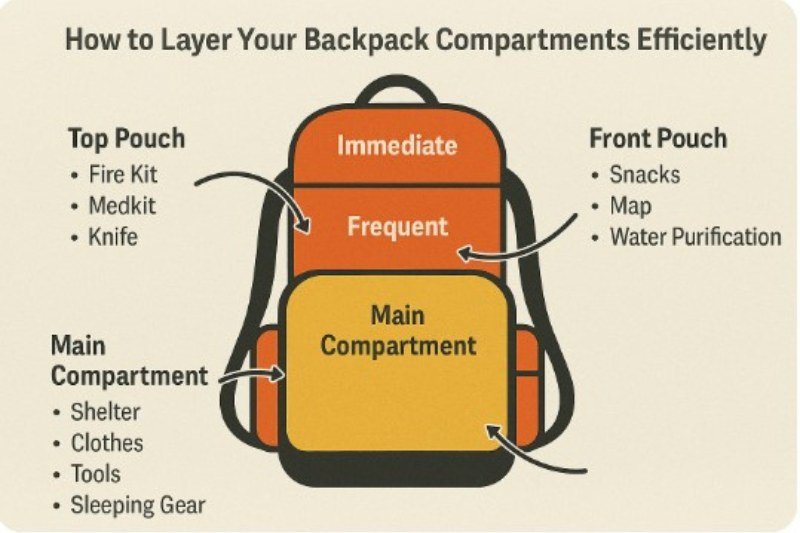
Avoid the black hole of “just stuff it in there.” Your gear should follow a layered access strategy:
| Zone | Contents | Priority |
|---|---|---|
| Top pouch | Fire kit, medkit, knife | Immediate |
| Front pouch | Snacks, map, water purification | Frequent |
| Main compartment | Shelter, clothes, tools | Mid/Heavy |
| Side pouches | Flashlight, gloves, multitool | Grab-n-go |
| Bottom panel | Sleeping gear, spare shoes | Setup time |
✅ Use color-coded pouches, zipper tags, or tactile identifiers (paracord knots, patches) for quick recognition.
🛠️ Customize With Purpose
Every prepper has different needs. What works for a solo urban evacuee won’t work for a family in the wilderness. So make the bag yours:
- Add MOLLE pouches for specific tools (radio, hygiene, solar charger)
- Use Velcro morale patches to ID gear by function
- Install internal dry bags for food, meds, electronics
- Attach glow sticks or tritium tags for nighttime use
- Tuck an emergency contact card in a sealed sleeve inside
✅ Rule: If you don’t know where it is—or why it’s there—it doesn’t belong in your pack.
🌦️ Rotate for Seasons and Missions
Survival isn’t static. Your backpack shouldn’t be either.
- In summer: swap heavy wool for ultralight layers
- In winter: add gloves, bivy bag, fat-rich rations
- In urban threats: add maps, local language cards, N95 masks
- In forest scenarios: add insect repellent, bear spray, trail markers
✅ Use a seasonal rotation calendar (every 3–4 months) to audit contents, refresh perishables, and update plans.
🔍 Test in Harsh Environments
Don’t trust it until it’s been wet, dropped, and dragged.
Push your backpack before the world does.
- Soak it in the rain
- Drag it over gravel
- Sleep with it as a pillow
- Throw it off a hill
- Crawl with it in mud
Sounds extreme? That’s the point. If it survives you—it will survive disaster.
✅ If your zipper fails now, you can fix it. In a real crisis, failure = consequences.
🧠 Build “Pack Bond”
There’s a psychological phenomenon in military and wilderness culture called “pack bond.” It’s the emotional trust you develop in the tool that carries your life.
The more you train with your survival backpack:
- The more intuitive your decisions become
- The less you second-guess your gear
- The faster you can operate under stress
- The more you conserve energy in crisis
Bonding with your pack is about building confidence. And in collapse scenarios, confidence keeps you alive longer than luck.
🧭 Final Preparedness Audit
Before you trust your pack to carry your life, run this quick checklist:
✅ I’ve carried it for at least 10 km under full load
✅ I can access fire, med, and flashlight in under 15 seconds
✅ I’ve slept outside with only the contents of my pack
✅ I’ve rotated gear for current season and location
✅ I know every item by location and purpose
✅ I’ve trained with it in darkness and poor weather
✅ I trust it enough to leave home with nothing else
If you can’t check every box—you’re not ready yet. Fix it now, while you still have time.
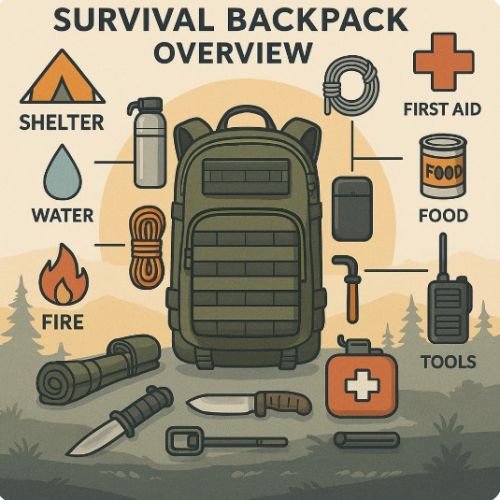
❓ Frequently Asked Questions (FAQ)
🎒 How do I choose the right backpack size for survival without overpacking?
One of the most common mistakes beginners make is thinking bigger means better. But in survival, every gram matters. A 70-liter backpack might carry everything… but can you run with it? Climb over a fence? Crawl through a tight alley?
Here’s how to choose the right size:
- For a 72-hour bug-out bag, 35 to 50 liters is often enough.
- For long-term survival or cold climates, 50 to 70 liters allows more layering, food, and shelter gear.
- If you’re prepping for urban escape, keep it discreet and agile—40 liters with a gray or earth-tone finish is ideal.
Most importantly, train with your pack at full weight. You might realize you’ve packed things you’ll never use—or forgotten what you truly need.
✅ Tip: Use a scale. If your fully loaded pack is more than 25–30% of your body weight, reduce or restructure it. Survival is about efficiency, not hauling gear like a pack mule.
🧠 What makes a “tactical” backpack different from just a hiking bag?
At first glance, tactical and hiking backpacks seem similar. Both carry gear, both strap to your body. But the purpose behind the design changes everything.
| Feature | Tactical Backpack | Hiking Backpack |
|---|---|---|
| Design Purpose | Combat, survival, adaptability | Comfort, terrain endurance |
| Modularity | MOLLE / PALS system | Few external options |
| Durability | 1000D Cordura, reinforced seams | Lightweight fabrics, minimal build |
| Color/Profile | Camouflage, muted tones | Bright colors, visible branding |
| Access | Multiple zip zones, top + front | Top-load or single access point |
Tactical packs are made to be beat up, modified, and carried into danger. Hiking packs are made for comfort over long distances. In a survival context—tactical wins, especially when stealth and adaptability matter more than ultralight design.
🌧️ Is waterproofing absolutely essential in a survival backpack?
Yes. Without hesitation. Water destroys gear faster than most people realize.
Imagine your survival gear soaked during a storm:
- Your clothes become dead weight.
- Your fire-starting tools fail.
- Your medical supplies get contaminated.
- Your electronics short out.
- Your food spoils.
That’s not a bad day—it’s a compounding crisis. That’s why built-in water resistance is a non-negotiable survival backpack feature.
Look for:
- PU-coated or ripstop materials
- Storm flaps over zippers
- Drainage holes in the lower compartments
- Separate dry compartments for sensitive items
Also consider using internal dry bags or Ziplocs to isolate categories. Waterproof your documents, cash, maps, phone, batteries, and first aid supplies as if your life depends on it—because someday, it might.
🧪 How can I know if my survival backpack will hold up in a real disaster?
You don’t know—until you test it. No amount of brand reputation or Amazon reviews replaces field testing under stress.
Here’s how to simulate real survival conditions:
- Load Test: Fill it with your actual bug-out gear. Walk 10+ km. Climb stairs. Crawl under obstacles. Do this with gloves and in full gear.
- Weather Test: Soak it with a hose or wear it through a thunderstorm. Then open it and inspect each compartment.
- Access Test: Try retrieving essential items blindfolded or in darkness. Time yourself.
- Durability Test: Drop it fully packed from shoulder height. Yank on straps. Drag it on gravel or concrete.
- Endurance Test: Camp overnight using only your backpack contents. Can you shelter, eat, hydrate, treat injury, and stay warm?
Only once it passes these tests without critical failure can you begin to trust your backpack with your survival.
✅ And remember: don’t wait for the crisis to test it. Test now, adapt now, survive later.









